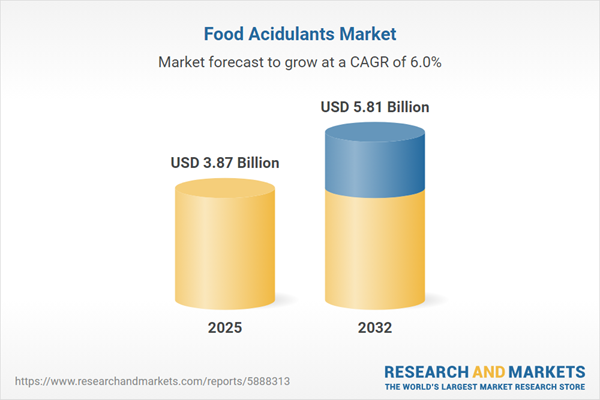Speak directly to the analyst to clarify any post sales queries you may have.
The food acidulants market is undergoing significant transformation as global supply chains, evolving regulations, and process innovations redefine business models. Senior decision-makers in the sector are focusing on agility and differentiation, leveraging new technologies to capture growth and sustain competitive advantage.
Market Snapshot: Food Acidulants Market Size & Growth
In 2024, the global food acidulants market reached USD 3.65 billion, with a compound annual growth rate (CAGR) of 5.96%. Growth is propelled by advancing sustainability practices in sourcing, broader adoption of bio-based manufacturing, and the integration of multifunctional ingredients across production lines. Food acidulants are critical for quality enhancement, shelf-life extension, and ensuring statutory compliance across international borders. The role of these ingredients is expanding within the food and beverage value chain, as manufacturers prioritize operational consistency and elevate performance through innovation in supply chain solutions.
Scope & Segmentation of the Food Acidulants Market
This report provides clear, actionable intelligence by analyzing the key segments and market dynamics that inform both strategy and execution in the food acidulants industry.
- Application Areas: Acidulants help preserve and stabilize products across bakery, confectionery, beverages, dairy, frozen foods, prepared meals, meats, poultry, seafood, dressings, and sauces, addressing diverse formulation needs.
- Acidulant Types: The study assesses a wide variety of acids such as acetic, citric, lactic, malic, phosphoric, and tartaric, identifying how sourcing and selection influence product formulation and sensory outcomes.
- Form Factors: Liquid and powder forms are evaluated regarding their contributions to process efficiency, manufacturing versatility, and integration into automated production systems.
- Functional Roles: Acidulants perform key functions such as flavor optimization, freshness preservation, adherence to regulatory standards, and upholding operational consistency.
- End-Use Industries: Utilization now moves beyond food and beverage into segments like animal nutrition, personal care, and pharmaceuticals, reflecting broadening relevance and application diversity.
- Distribution Channels: Market reach and buyer behavior are shaped by routes including commercial food service, institutional procurement, and retail channels, each influencing supply dynamics.
- Regional Focus: The report analyzes regulatory and consumer preference nuances in priority markets such as the United States, China, India, Germany, and Japan, ensuring localization of strategy.
- Technology Applications: Innovations such as biofermentation, encapsulation, and enhanced digital traceability are explored to illustrate their effects on quality control and regulatory compliance.
- Market Developments: Strategies of leading providers—Corbion N.V., Archer Daniels Midland, Cargill, Tate & Lyle, Ingredion, Kerry Group, DuPont, International Flavors & Fragrances, Fufeng Group, and Meihua Holdings—are profiled to demonstrate directional shifts and investment patterns in the sector.
Key Takeaways: Strategic Insights for Food Acidulants Stakeholders
- Embracing renewable sourcing and digital traceability improves continuity and fosters alignment with evolving compliance requirements and consumer transparency expectations.
- Utilizing new processing technologies, including encapsulation and real-time data monitoring, gives organizations a platform for rapid product development and proactive response to changing regulatory frameworks.
- Establishing robust, regionalized supply chains strengthens resilience against regulatory upheaval or geopolitical disruptions and allows better management of localized challenges.
- Sensory research paired with thorough validation enables companies to cater to varied market preferences, thereby supporting product differentiation and enhanced brand positioning.
- Strategic engagement with innovative technology providers and supply partners opens access to high-growth applications, enhancing regulatory efficiency and operational flexibility.
- Expanding into emerging use-cases such as personal care and pharmaceuticals unlocks diversification and supports the development of new long-term revenue streams.
Tariff Impact on Cost and Innovation Pathways
Recent shifts in United States tariff policy have prompted producers to favor domestic sourcing strategies and increase investment in bio-based feedstocks. This shift supports greater supply reliability and cost predictability, while increased adoption of traceability and compliance technologies enables organizations to meet revised standards efficiently and maintain robust supply chain transparency.
Methodology & Data Sources
Insights in this report are derived from interviews with specialists in product development, regulatory affairs, and supply management. Data sources include technical journals, open-access databases, patent documentation, and scenario modeling, providing a multi-faceted view of the market landscape.
Why This Report Matters
- Senior executives receive essential guidance for anticipating regulatory trends and adapting core operations through the latest advancements in acidulant applications.
- Strategic and sourcing teams gain frameworks for optimizing procurement and mitigating supply, quality, or compliance risk in a shifting industry context.
- Access to benchmarking insights identifies under-leveraged market segments, supporting the development of resilient, future-oriented strategies for enterprise growth.
Conclusion
Investment in advanced technology, supply chain innovation, and vertical expansion positions organizations to outpace industry shifts. These insights support resilient leadership and effective, growth-driven strategies across the evolving global food acidulants landscape.
Additional Product Information:
- Purchase of this report includes 1 year online access with quarterly updates.
- This report can be updated on request. Please contact our Customer Experience team using the Ask a Question widget on our website.
Table of Contents
3. Executive Summary
4. Market Overview
7. Cumulative Impact of Artificial Intelligence 2025
Companies Mentioned
The companies profiled in this Food Acidulants market report include:- Corbion N.V.
- Archer Daniels Midland Company
- Cargill, Incorporated
- Tate & Lyle PLC
- Ingredion Incorporated
- Kerry Group PLC
- DuPont de Nemours, Inc.
- International Flavors & Fragrances Inc.
- Fufeng Group Company Limited
- Meihua Holdings Group Co., Ltd.
Table Information
| Report Attribute | Details |
|---|---|
| No. of Pages | 181 |
| Published | November 2025 |
| Forecast Period | 2025 - 2032 |
| Estimated Market Value ( USD | $ 3.87 Billion |
| Forecasted Market Value ( USD | $ 5.81 Billion |
| Compound Annual Growth Rate | 5.9% |
| Regions Covered | Global |
| No. of Companies Mentioned | 11 |









